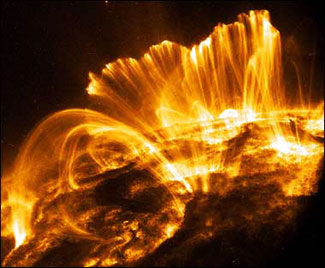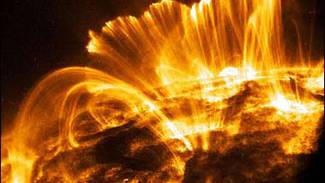'Pipe organ' plays above the Sun
Source: news.bbc.co.uk
 Coronal loops are generated by the Sun's magnetic field. Listen: Acoustic waves |
These "coronal loops" carry acoustic waves in much the same way that sound is carried through a pipe organ.
Solar explosions called micro-flares generate sound booms which are then propagated along the coronal loops.
"The effect is much like plucking a guitar string," Professor Robert von Fay-Siebenbuergen told BBC News at the National Astronomy Meeting in Preston.
The corona is an atmosphere of hot, electrically-charged gas - or plasma - that surrounds the Sun. The temperature of the corona should drop the further one moves from the Sun.
But, in fact, the coronal temperature is up to 300 times hotter than the Sun's visible surface, or photosphere. And no one can explain why.
Fiery fountains
The coronal loops arch hundreds of thousands of kilometres above the Sun's surface like huge fiery fountains, and are generated by the Sun's magnetic field.
As solar plasma travels from the photosphere into the loops, it is heated from about 6,000 Kelvin (5,700C) to upwards of one million Kelvin.
Solar explosions called micro-flares can release energy equivalent to millions of hydrogen bombs.
These blasts can send immensely powerful acoustic waves hurtling through the loops at tens of kilometres per second, creating cosmic "organ music".
"These loops can be up to 100 million kilometres long and guide waves and oscillations in a similar way to a pipe organ," said Dr Youra Taroyan, from the Solar Physics and Space Plasma Research Centre (SP2RC) at the University of Sheffield.
The sound booms decay in less than an hour and dissipate in the very hot solar corona.
Professor von Fay-Siebenbuergen, who is director of SP2RC, said that studying how plasma is heated to such high temperatures in coronal loops could speed up the technological development of industrial-scale nuclear fusion on Earth.
'Star on Earth'
Nuclear fusion is the same process which powers the Sun and other stars. Unlike the burning of fossil fuels, fusion reactions produce no carbon dioxide, the greenhouse gas blamed by scientists for warming the planet.
Fusion works on the principle that energy can be released by forcing together atomic nuclei rather than by splitting them, as in the case of the fission reactions that drive existing nuclear power stations.
In the core of the Sun, huge gravitational pressure allows this to happen at temperatures of around 10 million Celsius.
At the much lower pressure that is possible on Earth, temperatures to produce fusion need to be much higher - above 100 million Celsius
In nuclear fusion experiments, powerful magnetic fields can be used to isolate hot plasma from the walls of a containment vessel.
This reduces the conductive heat loss, allowing the electrified gas to be heated to high temperatures.
The most promising magnetic confinement systems are ring-shaped; called a torus.
Professor von Fay-Siebenbuergen said a coronal loop could give clues to improving nuclear fusion because it could be regarded as a half-torus.
The Royal Astronomical Society's National Astronomy Meeting in Preston runs from 16-20 April.
Article from: http://news.bbc.co.uk/2/hi/science/nature/6574059.stm






















